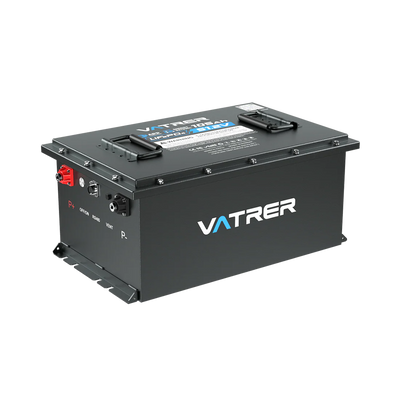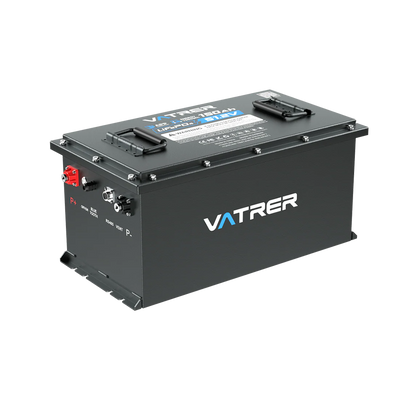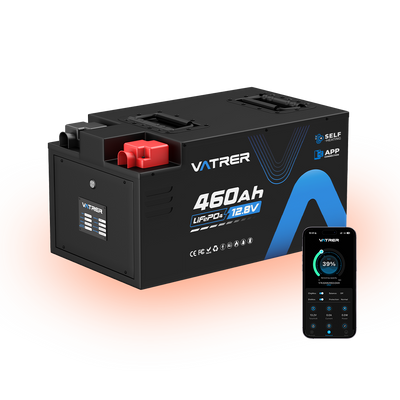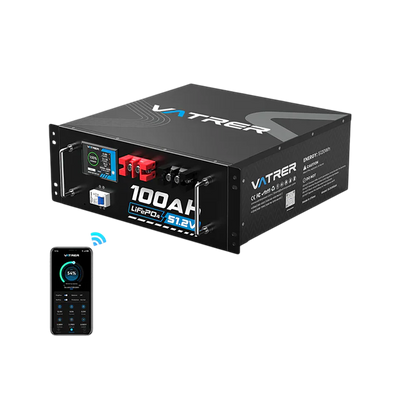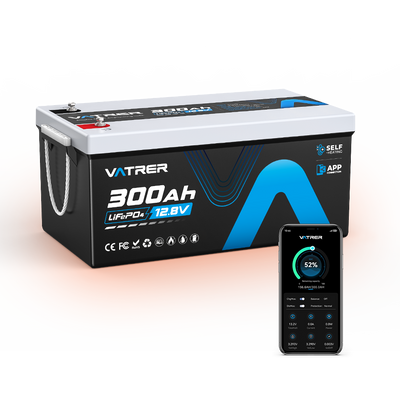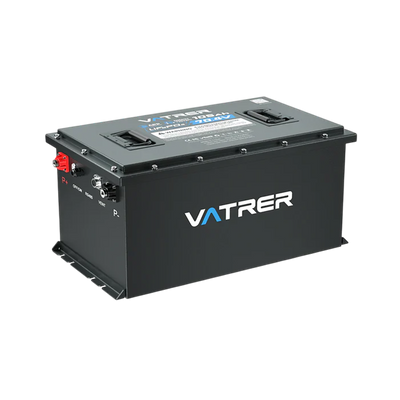How to Maintain Golf Cart Battery: Keep It in Top Condition
Reading time 13 minutes
Golf carts are a favorite for cruising the course, navigating neighborhoods, or handling light tasks, with over 100,000 sold yearly in the U.S. The key to their smooth operation? Whether you're using a traditional lead-acid setup or considering a lithium-ion upgrade, knowing how to maintain golf cart batteries ensures reliable performance and a longer lifespan. This guide is all about helping you keep your golf cart battery in top condition. Let's dive into some practical tips to keep your cart running smoothly.

What Are Golf Cart Batteries and How to Choose the Right One
Before you start maintaining golf cart batteries, understanding their types and features helps you make smart maintenance and purchase decisions. This foundational knowledge ensures you're equipped to keep your battery running strong.
Golf cart batteries are designed for deep cycling, meaning they can be discharged and recharged repeatedly. Lead-acid batteries include flooded lead (FLA), absorbed glass mat (AGM), or gel-type lead-acid batteries, with common voltages of 6V, 8V, or 12V. Golf cart voltage systems are typically 24V, 36V, or 48V (48V is standard for most golf carts). Lithium-ion batteries are increasingly popular due to their lightweight design and minimal maintenance costs. They are often equipped with a battery management system (BMS) to regulate charging and protect the battery.
Here's a comparison to guide your choice:
| Battery Type | Voltage Options | Typical Runtime (at 56 amps) | Key Considerations |
|---|---|---|---|
| 6-Volt Lead-Acid | 6-8 for 36-48V | Up to 164 minutes | Long range, but higher cost and more units needed |
| 8-Volt Lead-Acid | 4-6 for 32-48V | ~128 minutes | Cost-effective, compact, but shorter range |
| 12-Volt Lead-Acid | 4 for 48V | ~110 minutes | Budget-friendly, easy install, shortest runtime |
| Lithium-Ion | 48V standard | 200+ minutes (varies by capacity) | Higher initial cost, low maintenance, 5-10-year lifespan |
You can determine the best battery for your golf cart based on its specifications and intended use (long-distance golfing or short business trips). Such as Vatrer golf cart lithium battery, offer 5,000+ cycles and weigh 70% less than lead-acid, making them ideal for users seeking efficiency and durability. Check your cart's manual to match voltage and capacity needs before upgrading.
How to Perform Routine Maintenance for Golf Cart Batteries
Maintaining golf cart batteries is all about building simple, consistent habits to keep your cart running smoothly, whether you're dealing with lead-acid or lithium-ion batteries. By focusing on regular inspections, proper cleaning, precise watering (for lead-acid), and smart charging, you can extend battery life and avoid unexpected downtime. Here's a clear breakdown of how to maintain golf cart batteries with practical steps tailored to each battery type.
Step 1: Inspect Regularly for Early Problem Detection
Start with a visual check every 2-3 weeks, especially at the beginning of the golfing season. Lift your cart's seat or storage compartment to access the battery pack. Look for signs of wear like cracks, bulges, or loose cables, which can signal damage or connection issues. Clear any debris—dirt or leaves—on battery tops, as it traps moisture and invites corrosion. before check, always wear gloves to protect against acid exposure from lead-acid batteries or electrical risks from lithium-ion units. This helps catch small issues before they escalate.
Step 2: Clean Terminals to Ensure Strong Connections
Cleaning keeps your battery's connections reliable.
- For lead-acid batteries, mix a solution of baking soda and water (1 tablespoon per cup) and use a toothbrush or bristled brush to scrub corrosion off terminals. Rinse carefully with distilled water, dry with a lint-free cloth, and apply a thin layer of petroleum jelly or anti-corrosive spray to prevent future buildup.
- For lithium-ion batteries, which are sealed, simply wipe the casing with a dry cloth to remove dust. Avoid wearing jewelry during cleaning to prevent accidental sparks or shocks. Clean monthly or when you spot corrosion to maintain optimal performance.
Step 3: Water Lead-Acid Batteries Properly
If you use the lead-acid battery, watering is a must for lead-acid batteries but doesn’t apply to lithium-ion. After a full charge, check water levels in each cell using a flashlight. Use only distilled water—tap water's minerals damage cells—and fill to 1/4 to 1/2 inch above the plates. A common 6-volt lead-acid battery may need about 15 liters over its 3-5-year lifespan, depending on usage and climate. Use a watering gun for precision to avoid overfilling, which causes acid spills and corrosion, or underfilling, which exposes plates and increases flammable hydrogen gas during charging. Check monthly during heavy use or hot weather.
Step 4: Charge Smart to Maximize Battery Life
Proper charging is the cornerstone of maintaining golf cart batteries. Plug in after every use with a charger matched to your battery type.
- lead-acid typically needs 8-10 hours at 80% discharge, while lithium-ion charges in 2-4 hours. Avoid letting lead-acid batteries drop below 50% or lithium-ion below 20% to prevent sulfation or BMS shutdowns.
- Use a smart charger with auto-off for safe overnight charging, and prop the seat open to improve airflow and reduce corrosion buildup. For lithium-ion, target 80-90% charge to extend cycle life, as frequent 100% charges can stress cells, per most BMS guidelines. Check your charger's compatibility with your battery's voltage (like 48V) to avoid damage.
These four steps—inspect, clean, water, and charge—form a reliable routine for keeping your golf cart battery in top condition. Consistent care means more time enjoying your cart and less time worrying about battery issues.
Via Monitor Golf Cart Battery Health for Peak Performance
Regular monitoring golf cart batteries catches issues early, saving you from unexpected breakdowns. Whether you're tackling lead-acid or learning the best way to maintain lithium-ion batteries in a golf cart, simple tools and habits keep you informed.
- For lead-acid, use a hydrometer after charging to measure electrolyte density—1.275-1.280 indicates a full charge, while 1.140 signals deep discharge or a failing cell. A multimeter checks voltage consistency; uneven readings across the pack suggest a weak battery. For load testing, apply half the battery's rated capacity (like 50A for a 100Ah battery) for 15 seconds—a voltage drop below 9.6V for a 12-volt battery indicates weakness. Log results in a notebook or app to spot trends, especially for fleets.
- Lithium-ion batteries rely on their BMS for diagnostics. Many, like Vatrer Battery's, offer apps showing charge state, cell balance, and cycle count. Common alerts (like “cell imbalance”or “over-temperature”) may require a reset or professional service—check your manual for error codes. Use a multimeter for voltage checks, but follow lithium battery manufacturer specs, as ranges vary (e.g., 48V nominal may read 50-54V when full). Regular monitoring ensures early fixes, keeping your cart ready.
How to Stay Safe While Maintaining Golf Cart Batteries
Safety is a top priority when maintaining golf cart batteries, whether you're handling lead-acid or lithium-ion types. Proper precautions protect you, your equipment, and your surroundings. Before servicing your golf cart battery, please follow these safety recommendations:
Wear Protective Gear to Avoid Injury
Always wear non-conductive gloves to shield against acid burns from lead-acid batteries or electrical shocks from lithium-ion ones. Remove metal jewelry, like rings or watches, to prevent accidental sparks or short circuits. Eye protection is also wise, especially when handling lead-acid batteries, as acid splashes can occur during cleaning or watering.
Work in a Well-Ventilated Area
Perform maintenance in a well-ventilated space to reduce risks from hydrogen gas, which lead-acid batteries can emit during charging, especially if water levels are low. This gas is flammable and can pose an explosion hazard. For lithium-ion batteries, ventilation helps dissipate any heat buildup, reducing the risk of thermal issues.
Handle Acid Spills and Battery Damage Carefully
For lead-acid batteries, never charge a cell with low water levels, as this stresses plates and increases hydrogen gas production. If an acid spill occurs, neutralize it immediately with a baking soda and water mixture, clean with gloves, and dispose of waste according to local hazardous material regulations.
For lithium-ion batteries, avoid dropping or puncturing them, as damage can lead to thermal runaway, causing overheating or fires. If a lithium-ion battery feels hot, smells unusual, or shows signs of swelling, stop use and consult a professional immediately.
Store and Charge in Safe Conditions
Store batteries in a cool (50–77°F / 10-25°C), dry area away from heaters or freezing temperatures. Cold can crack lead-acid cases, while extreme temperatures affect lithium-ion performance. Use only manufacturer-approved chargers to prevent overcharging or electrical faults. For lithium-ion, check the Battery Management System (BMS) for alerts like “over-temperature” and follow the manual for troubleshooting.
By these steps, you can maintain your golf cart batteries safely, keeping both lead-acid and lithium-ion systems in top condition without risk.
How to Store Golf Cart Batteries During the Off-Season
Proper off-season storage keeps your battery primed for spring, preventing damage from neglect. Here's how to maintain golf cart batteries when your cart's parked for months.
Step 1: Prepare for Storage
Start by removing the batteries from the golf cart to avoid any electrical draw from the cart's systems. Clean the battery terminals with a baking soda and water mix for lead-acid (use a dry cloth for lithium-ion) to remove corrosion or debris. Wear gloves to protect against acid or electrical risks. Ensure the batteries are fully charged before storage—lead-acid should be at 100%, while lithium-ion is best at 50-60% charge, as recommended by most Battery Management Systems (BMS).
Step 2: Choose the Right Storage Environment
Store batteries in a cool (50–77°F / 10-25°C), dry, and well-ventilated location, such as an indoor shelf or climate-controlled garage. Avoid areas with extreme cold (below 32°F), as freezing can crack lead-acid cases or reduce lithium-ion capacity. Steer clear of heat sources like radiators, which can accelerate self-discharge or damage battery chemistry. Cover batteries with a dust-proof tarp to protect them from dirt and moisture.
Step 3: Maintain Charge During Storage
For lead-acid batteries, charge every three months using a maintenance-mode charger to counter natural self-discharge, which can lead to sulfation and reduced lifespan. Lithium-ion batteries have lower self-discharge rates, so a quarterly check via the BMS app (if available) is enough—recharge to 50–60% if below 20%. Always use a charger matched to your battery type to avoid damage.
Step 4: Minimize Power Drain
Disconnect all cables from the batteries to prevent parasitic draws. Set your golf cart to tow mode (check your manual) to ensure minimal power usage. This step is critical to avoid deep discharges, which can permanently harm both lead-acid and lithium-ion batteries.
Step 5: Check Before Reuse
Before reinstalling batteries in the spring, inspect for signs of damage (cracks, swelling, or leaks) and test lead-acid with a hydrometer (aim for 1.275-1.280) or lithium-ion via BMS diagnostics. Give them a full charge to ensure they're ready for the season.
By following these steps, you'll protect your investment and keep your golf cart batteries performing reliably when you're back on the move. For lithium golf cart batteries options that simplify storage, brands like Vatrer Battery offer low-maintenance packs with robust BMS, ensuring minimal upkeep during downtime.
How to Care for Your Golf Cart to Support Battery Life
Battery maintenance shines brighter with overall cart care. These habits reduce strain, boosting your efforts in maintaining golf cart batteries.
- Keep tires at 18-22 PSI (check your manual) to avoid motor overwork, which drains batteries faster.
- Inspect brakes monthly, replacing pads every 1-2 years or when below 1/8 inch thick to maintain efficiency.
- Stick to your cart's towing limit (500-1,200 lbs) to prevent overload.
- Regular use cycles batteries healthily, but seasonal users might consider gas carts for less upkeep.
- Drive smoothly, avoiding rough terrain, to keep the system—and your battery—in top shape.
Conclusion
Maintaining golf cart batteries boils down to regular care: inspect, clean, charge smart, and store properly. Whether you're managing lead-acid or mastering the best way to maintain lithium-ion batteries in a golf cart, these steps deliver reliable performance and fewer surprises. From hydrometer checks to BMS apps, you're building longevity into every ride.
If you're considering upgrading to a golf lithium battery, Vatrer batteries offer 5,000+ cycles, a lightweight design, an intelligent BMS, and feature low-temperature power-off and self-heating, allowing you to focus on the track rather than daily chores, making this a low-maintenance upgrade.
FAQs
How Do I Maintain Golf Cart Batteries in Winter?
Winter conditions can challenge both lead-acid and lithium-ion golf cart batteries, but specific steps ensure they stay in top condition. For lead-acid batteries, fully charge before storage and maintain a charge every 6–8 weeks using a maintenance-mode charger to prevent sulfation, which occurs faster in cold temperatures. Store in an indoor, climate-controlled space above 32°F to avoid case cracking due to freezing electrolyte. For lithium-ion batteries, store at 50–60% charge in a cool (50–77°F), dry area—avoid extreme cold below 32°F, which can reduce capacity. Check the Battery Management System (BMS) monthly for alerts and recharge if below 20%. Insulate batteries with a thermal blanket if stored in a garage prone to temperature swings. These steps, distinct from off-season storage, focus on winter-specific protection, ensuring your batteries are ready for spring use.
Can I Mix Lead-Acid and Lithium-Ion Batteries in My Golf Cart?
Mixing lead-acid and lithium-ion batteries in the same golf cart is not recommended due to their differing voltage profiles, charge rates, and discharge characteristics. Lead-acid batteries (e.g., 6V, 8V, 12V) require longer charging times and can't match the rapid charge/discharge efficiency of lithium-ion. Mixing them can cause uneven power delivery, overworking one battery type and leading to premature failure. For optimal performance, replace your entire battery pack with one type. If upgrading to lithium-ion, brands like Vatrer Battery offer 48V packs with integrated BMS, ensuring consistent power and simplified maintenance for golf cart users.
How Do I Troubleshoot a Golf Cart Battery That Won't Hold a Charge?
If your golf cart battery isn’t holding a charge, follow these steps to diagnose and resolve the issue. For lead-acid, use a hydrometer to check electrolyte density—readings below 1.200 after charging suggest a failing cell. Test voltage with a multimeter; a 12-volt battery reading under 12.4V when idle indicates weakness. Inspect for sulfation (white buildup on plates) or loose connections, and clean terminals as needed. For lithium-ion, check the BMS app for alerts like “cell imbalance” or “low voltage”—reset per the manual or consult a technician. Ensure your charger matches the battery’s specs, as mismatched chargers can undercharge. If issues persist, test the cart’s electrical system for parasitic draws (e.g., lights left on). Persistent problems may require professional testing or replacement to restore reliable performance.
How Often Should I Equalize Lead-Acid Golf Cart Batteries?
Equalization is a controlled overcharge process for lead-acid batteries to balance cells and remove sulfation, but it’s not needed for lithium-ion. Perform equalization every 1–2 months for flooded lead-acid (FLA) batteries during heavy use, or when hydrometer readings show cell imbalances (e.g., varying by more than 0.015). Use a charger with an equalization mode, typically applying 15–16V for a 12-volt battery for 2–4 hours, per manufacturer guidelines. Avoid over-equalizing, as it can dry out electrolyte or damage AGM/gel types. Check water levels post-equalization and top up with distilled water. Regular equalization extends lead-acid battery life, ensuring consistent performance for your golf cart.
What Are the Signs of a Failing BMS in a Lithium-Ion Golf Cart Battery?
The Battery Management System (BMS) in lithium-ion golf cart batteries regulates charging and protects cells, so a failing BMS can disrupt performance. Signs include frequent “cell imbalance” or “over-temperature” alerts on the BMS app despite normal use, sudden power cutoffs at moderate charge levels (e.g., 30–50%), or inability to charge past a certain percentage (e.g., 80%). Use a multimeter to verify voltage against manufacturer specs—if readings are inconsistent with app data, the BMS may be faulty. Avoid DIY repairs, as BMS issues require specialized tools. Contact the manufacturer or a certified technician for diagnostics and recalibration. Choosing reliable brands like Vatrer Battery, with robust BMS designs, minimizes these issues and supports the best way to maintain lithium-ion batteries in a golf cart.
How Can I Extend the Lifespan of My Golf Cart Battery Beyond Routine Maintenance?
Beyond routine care, optimizing usage habits can further extend your golf cart battery’s lifespan. For both lead-acid and lithium-ion, avoid extreme temperature exposure—park in shaded areas during hot weather (above 90°F) to prevent overheating, which degrades cells. Limit high-power demands, like towing heavy loads beyond 1,200 pounds, to reduce battery strain. For lithium-ion, use a charger with a “partial charge” setting to maintain 80–90% charge, preserving cycle life. Schedule annual professional inspections to catch hidden issues like cable wear or controller faults. Regular driving (weekly, even for short trips) keeps batteries cycled and healthy, especially for lithium-ion packs like Vatrer Battery’s, which thrive on consistent use and offer 5,000+ cycles for long-term reliability.
Share













































































